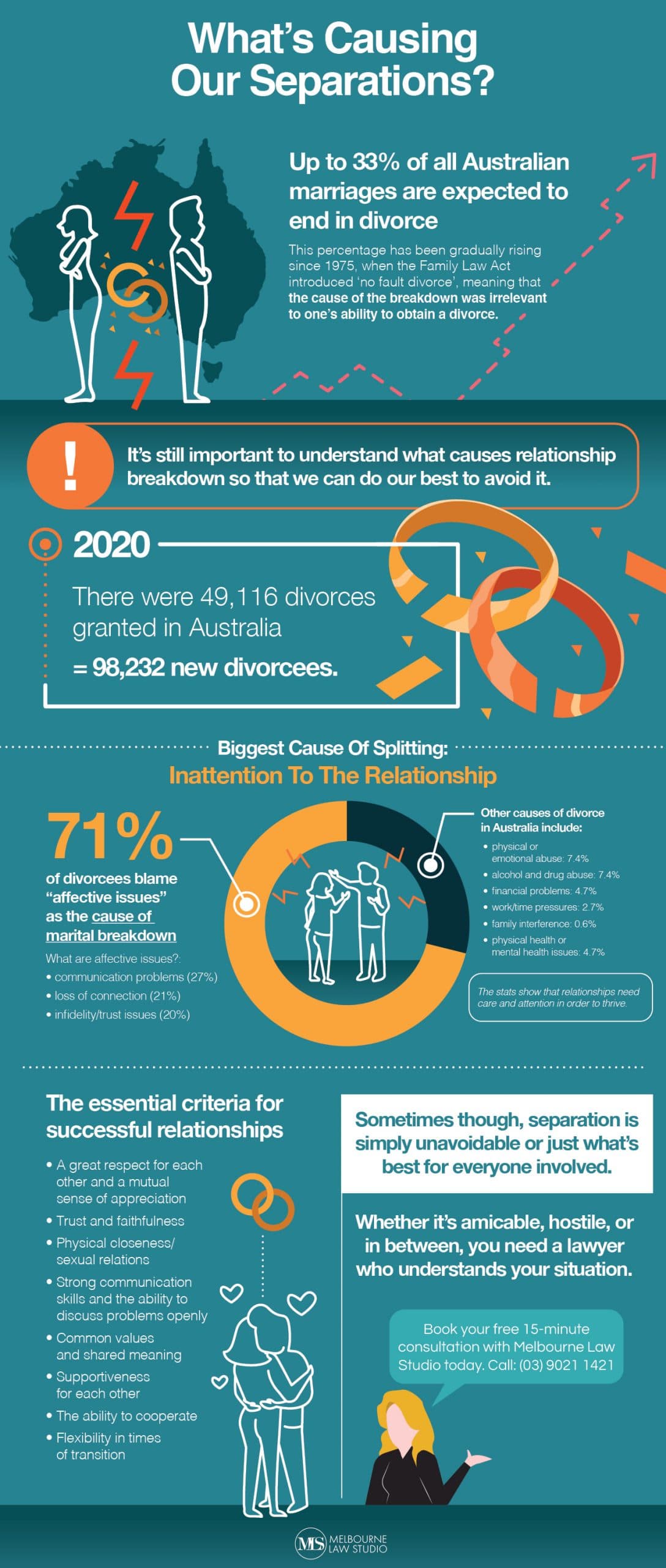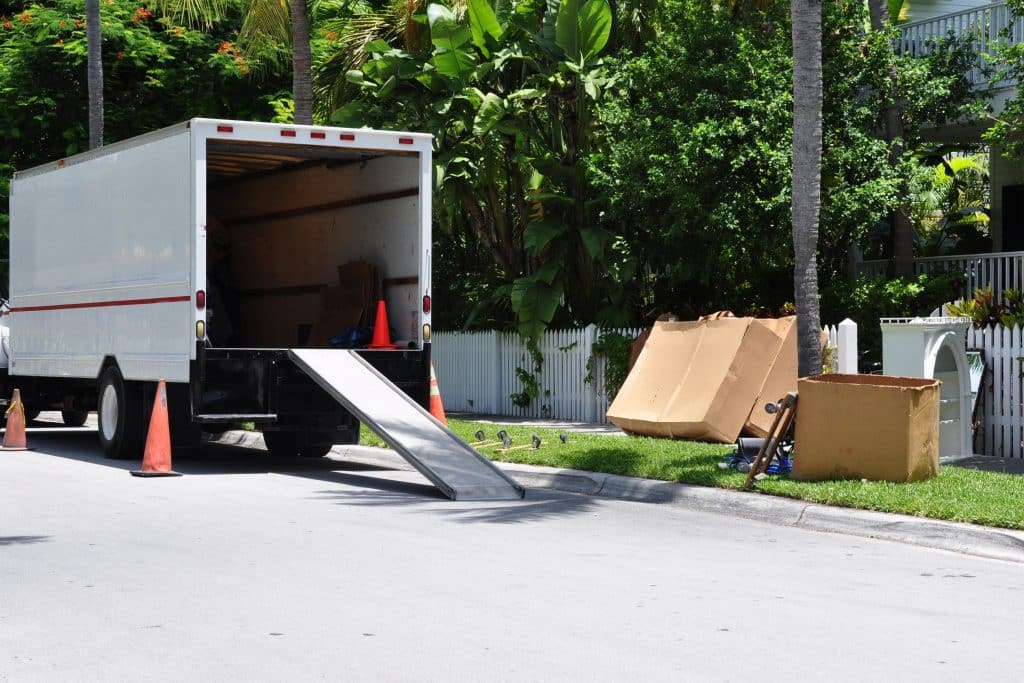What's discussed in this article:
If you’ve experienced a breakdown of your marriage or have come to the point where you know a life together is no longer tenable, then you know that divorce is unavoidable.
We know what a difficult decision this is for people (no matter what the reason or who decided it) so Melbourne Law Studio is here to help.
We wholeheartedly believe in giving our clients the information and tools to make the best decisions for them, which is why we have put together this helpful guide on the Australian divorce process.

There is no need to feel overwhelmed or ashamed. We cannot promise you a stress-free ride, but what we can guarantee is that you will be well looked after, supported and most importantly, in the best hands.
If you have separated or are getting a divorce, we are here to listen, give advice and guide you through the process. Melbourne Law Studio puts its clients’ interests and wellbeing above all else. We know that you are already dealing with an incredibly stressful and emotional time. On top of that, you’ve got to continue with the obstacles of daily life while you tackle the different stages of divorce and determine which steps you need to take. If you’re not careful, the stress of divorce can really get to be too much.
Sadly, there are many stages to the Australian divorce process and even if it is an amicable split, you need a lawyer to protect your interests and ensure you are taken care of. Separation in and of itself can be a sea of confusions, so you should find someone to navigate the legal waters whilst you deal with the emotional stress and turmoil of it all. You can trust Melbourne Law Studio to look after you and be your team. You don’t have to go through this alone.
This guide will walk you through the first steps of getting a divorce in Victoria and answer some really common questions we get asked, from whether you need to go to court to the cost of divorce in Australia. If you are after advice about your specific situation, you can book an online or in-person consultation with our team of loyal and friendly Melbourne divorce lawyers. Before we dive into the Australian divorce process, it’s important to understand what a divorce actually is.

In Australia, divorce is defined as the ending of a marriage. It’s important to note that you can only remarry once the divorce has been finalised. Australia adopted a no-fault divorce system in 1975. According to the Family Court of Australia, this means that when the Court grants a divorce it doesn’t consider who is at fault, only that there was an irreparable breakdown in the marriage and there’s no reasonable likelihood that the two parties will get back together.
This essentially means that neither partner needs to blame or find fault in the other to get the divorce. Remember, divorce is an entirely separate process to property settlement, financial settlement, or parenting matters. Each of these issues must be dealt with independently. We strongly recommend dealing with all other matters first and then apply for divorce, as there are time limits associated with property settlements once the divorce is finalised.
At Melbourne Law Studio, we’ve got your legal concerns covered. Book your online or in-person consultation today to see how we can help.
https://youtu.be/wnSmzzcOHOI

You need to prove to the Family Court of Australia that they have jurisdiction to deal with your case and ensure that you are eligible. To get a divorce in Australia, either you or your spouse:
It’s a straightforward step, but one that's essential to the Australian divorce process and definitely worth checking.
You will have to prove to the courts that you have been married and provide them with a marriage certificate so that they can confirm the date. If your marriage certificate is in a different language, you will need to ensure that this is translated into English before the Court will accept it. If you have lost or misplaced your original marriage certificate, our friendly family law experts are happy to talk you through the steps involved in replacing it.
If you’ve been married less than two years, you and your spouse will be required to attend an appointment with a councillor to discuss the idea of reconciliation. If for whatever reason this is not possible, you will have to obtain an affidavit stating why you are not able to do so and file the affidavit with your divorce application.
You will have to provide the Court with proof that you and your former partner have been separated for at least 12 months before you are able to file for divorce. The date of separation is generally counted from the day the separation was communicated to the other side (or agreed upon by the parties in the event of an amicable and unified split).
You aren’t required to officially notify the courts of your separation, however, it is extremely important that you take note of the date that you and your partner separate. The easiest way to do this is by sending an email to your partner that notifies them that you now consider yourself to be separated from them.
While you do have to be separated for a period of 12 months to get a divorce in Victoria, the Family Court of Australia does allow you to reconcile for a period of up to three months without restarting the separation process. For instance, if you and your partner are separated for two months but get back together for a period of almost three months, and then separate for a further ten months, this will count as a 12-month separation, and you can proceed to finalise your divorce.
It is possible to be separated while living under the same roof, the Court will just want to know a few things so that they can determine if you are genuinely separated. The Court will consider:
If you are living under the same roof but consider yourself separated, you will need to provide a supporting affidavit.
Remember, a divorce does not sort out any issues relating to property division or a child custody agreement. If you and your former partner have children under the age of 18, the Court will need to be satisfied that they are cared for, safe and have a place to live before granting the divorce.
Additionally, any division of property must be completed within 12 months of the divorce order. This stage of the divorce process can become pretty tricky if you’re unable to come to an agreement. Get in touch with our family divorce lawyers for an online or in-person consultation.

After completing the preliminary steps, you’ll be ready to submit your application for divorce. Many people apply for their divorce online through the Commonwealth Courts Portal. You can apply by yourself or with your partner, which is called a joint divorce application. Joint divorce applications don’t require you to attend court, however if you’re making a sole application and your children were under the age of 18 at the time of separation, you will be required to. Once you’ve completed the form, you will have to swear or affirm it in the presence of a Justice of the Peace, or a Melbourne divorce lawyer.
If you have decided to complete a solo application, you are required to serve your divorce application on your former partner. If your former spouse is living in Australia, the documents must be served at least 28 days before the court hearing. If they live overseas, they must be served 42 days before the court hearing. If you are unable to locate your spouse, you can apply for an order to dispense with service or for substituted service. Joint divorce applications do not require you to serve papers. If you need any further information about how to serve your former partner, you may wish to watch this video.
This step of divorce depends on your circumstances. Going to court isn’t always necessary for a divorce in Victoria, however it is required if:
The divorce is finalised one month and one day after the hearing. The Court will issue a divorce certificate. Due to the numerous steps you need to take to ensure your divorce application is successful, hiring a lawyer will make the process so much less stressful. Our team of family law experts are happy to assist you and offer an online or in-person consultation.

The process of filing for divorce in Australia is the same nationally and does not differ between any of the states. If you’re still wondering how to get a divorce in Victoria, you don’t need to do anything other than what has been mentioned above.
Many people wonder if they have to sign divorce papers to get a divorce, or what happens if their ex-partner won’t sign. If your ex-partner won’t sign the divorce papers, it will not matter. You will simply file a solo application and go to court when the time comes.
In order to get a divorce, the Court requires that you and your former partner have been separated for a period of 12 months.
You are not allowed to remarry until your divorce order becomes finalised. Usually, this is one month and one day after the divorce hearing. However, it could be prudent to avoid booking a wedding immediately following this date, as you never know what complications may arise at the last moment and delay the divorce proceedings.
People often ask how to get a divorce quickly because the marriage has become untenable, and they want to move on as soon as possible. Unfortunately, in Australia there’s no such thing as getting a divorce quickly. You simply must be separated for a period of 12 months before you’re able to file for divorce. However, uncontested joint applications will usually be processed much faster than solo applications, as you don’t need to go to court.
It is possible to obtain a divorce in Australia, even if you were married overseas. It would just depend on whether:
People who wish to quickly move on to a new stage in their life will be thankful to know that the divorce process is not overly long. After you file your divorce application, it shouldn’t take more than 3-4 months for the entire process to be finalised. Once the application is processed, you will receive a divorce certificate which confirms you are now legally divorced.
Applying for a divorce will cost you a filing fee of $930 according to the Family Court of Australia. This does not include legal fees paid to a lawyer for their assistance if you hire a firm to assist you. For some individuals, certain circumstances might mean you’re eligible for a reduced filing fee, which would come down to $310. To qualify for this reduced amount, you will have to provide certain evidence to the Court.
If you’re a sole applicant, you’ll have to ensure you provide this to the Court by yourself. If you’re applying jointly with your former partner, then both of you will have to provide this evidence. The application fee will have to be paid before you are able to move forward with your divorce application. If you’re experiencing financial hardship, you might be able to have the fee waived or reduced even further.
As we said, there are differences between applying as a sole applicant, or together, which is called a Joint Divorce Application. This type of filing for divorce makes things easier as it simply means that both parties are in mutual agreement. Another advantage in these cases is that neither party will have to attend a court hearing.
Yes, you can, however, it’s best to seek legal advice to learn the details that are involved in the process, even if your divorce promises to be a smooth ride. A divorce lawyer will represent your rights and go through the step-by-step stages of the procedure.
Generally speaking, you cannot. As Australia has a “no-fault” divorce system, the only condition to grant a divorce is that the couple has been separated for 12 months without any intention of getting back together. The only ground you would have to oppose a divorce is if you could prove that there were factual errors on your former partner’s application.
For example, you’ve been separated for less than 12 months or intend to get back together. In other words, just not wanting to get a divorce doesn’t offer legal grounds to oppose the original application and the active avoidance or refusal to accept service of documents can frustrate the court process unnecessarily.
Not to mention that courts loathe having their time wasted. If you still wish to oppose the divorce, you need to file a Response to Divorce within 28 days of being served and attend the court hearing to present your case.
This will depend on your particular case. It’s very common for people not to attend their divorce hearing. Still, if there are children of the couple under the age of 18 and you have applied on your own, then you should attend. Please note, you will be able to state on your divorce application if you wish to do so or not.
If you need to be at the hearing but can’t be there in person, you’ll have to complete a Telephone/Video Link Attendance Request Form. Your ex-spouse will have to go to the hearing only if they oppose your divorce application and need to present the facts on their Response to Divorce.
Just as we explained at the beginning of this guide, this is when you are separated but are still living together in the same house.
In Australia, the Family Law Act states, a reason for divorce is not required. This means that it’s not a matter of whose fault or blame of either party. If you and your ex-spouse can prove the 12 months of separation and that there is no chance of reunification, then you can receive your divorce.
Your property and financial situation are not resolved during the process divorce. This can go down many different avenues. Some former couples work out their own arrangements without the need of going through the court system. Property and assets must be divided within the first 12 months after the divorce order is issued. If you are not successful at this, then you will need to submit a separate application to the Family Court of Federal Circuit.
The concept of Parental Responsibility states that both parents of a child under the age of 18 must take care of their wellbeing. This is not affected by the marital status of a couple, meaning that even after getting a divorce, they still hold equal responsibility in the bringing up of their children. If parents cannot arrange a child custody agreement after divorce, then there are different services to help solve this, before applying to the court. An example of this may be family mediation processes or attending a Family Dispute Resolution Conference.
Divorce can be scary, if you aren’t aware of all your options or what steps you should take. Our friendly lawyers can help you get through this process as quickly and painlessly as possible.
Melbourne Law Studio has offices in Melbourne’s CBD, St Kilda, Balaclava, Brighton, Toorak, Elsternwick, and the Mornington Peninsula. Call us today on 03 9021 1421 or contact us online to book an online or in-person consultation.
Book your one-hour strategy session, online or in-office, for personalised legal advice tailored to your situation.
Fixed fee: $550 (incl. GST).
Send us a message using the form below.